GPD MicroPC Handheld Computer ReviewJAke Fisher | Guest Reviews After its peak in the late 1990’s, Windows CE handheld usage dropped precipitously, and ever since, there have been uneven attempts to recapture the microcomputer market. Armed with better miniaturized technology and a decision to use a full-blown Windows OS, companies have produced commendable products such as the MBook M1 and the Fujitsu Lifebook U8xx series. Other corporations replaced Windows CE with a bastardized Linux, resulting in brief periods of success with the Sharp Zaurus and the Nokia N series, the latter even adding telephony to certain models. There was always interest, but not enough. After a spurt of netbooks in the mid 2000’s, small computing ground to a halt and it even became difficult to find a phone with a physical keyboard. Enter GPD, a Chinese-based company that has repeatedly turned to crowd-funding to manufacture an impressive line of diminutive machines. GPD has single-handedly recreated a niche market and stoked enough buyer enthusiasm so that GPD must now defend itself against competing companies and outright knock-offs. Its latest fruition is the GPD MicroPC, a six-inch computer that runs both Windows 10 and most flavors of Linux. Designed for “industry professionals and various mobile scenarios”, the device may be an IT delight, but can it also be a true replacement for aging Windows CE devices? Like most of life’s answers, it’s yes and no. The HardwareFirst off, while the MicroPC’s Gorilla Glass screen boasts a crisp 1280×720 resolution, it is not a touchscreen, instead driven by a small trackpad in the upper-right corner.
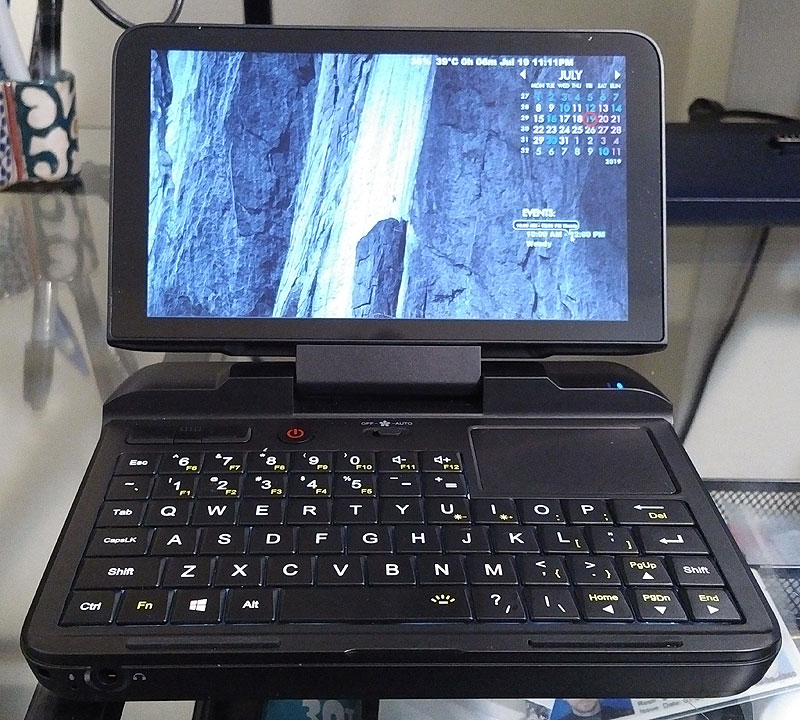
This may stop Windows CE users right there and certainly give left-handed folks pause. As a right-hander in a world of right-handed privilege, I find the trackpad to be perfectly usable and given that Linux and Windows 10 are not nearly as touch-friendly as Windows CE, I instinctively reach for the trackpad rather than the screen. The pad has single and double clicks, two-finger scrolling, and across the machine’s upper-left corner are left, middle, right hardware mouse buttons. The trackpad supports Windows 10 Gestures mode. The MicroPC’s keyboard is soundly built save for its startling arrangement of fn (function) keys/numbers. As you can see, the strip of key '6' through 'Vol+' resides above the strip of key '1' through '+/='. An odd call, and GPD is renowned for peculiar keyboard decisions. Thankfully, the rest of the layout is traditional, even cautious. The keyboard is tactile, responsive, and clearly designed for thumbing. When resting on a flat surface, the MicroPC does not lend itself to true touch-typing - forefinger through ring finger is about the best one can manage, with a thumb for the space bar. Even the Sharp Mobilon 4100 has a better size/layout for full-throttled typing. That said, the MicroPC keyboard is backlit and that handiness is instantly addictive. I can no longer imagine buying another small computer unless its own keyboard follows suit. And the backlit keyboard is just one of many features to admire on the MicroPC - GPD has truly crafted an ingenious device.
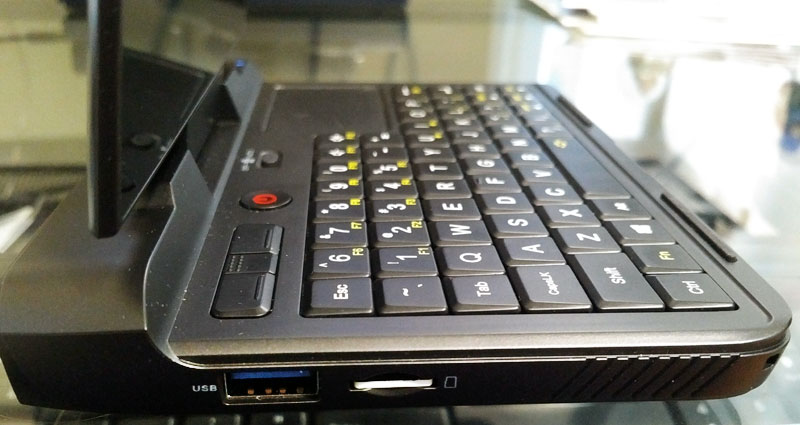
The computer holds a remarkable plethora of ports: 1 USB Type-C for PD 2.0-based fast charging and all data transmission, 3 USB 3.0, 1 Mini HDMI, Micro SDXC slot (2TB maximum), 1Gbps Ethernet (RJ45), built-in microphone, 3.5mm headphone jack and a genuine RS-232 serial port. Made for the field, anticipating accidents, the device promises a 97.63% survival rating after a 1.5m fall. The WiFi is 802.11a/b/g/n/ac and the Bluetooth version is 4.2. The accompanying multi-voltage charger is 5V-15V but the battery can also be charged with any 5V/3A mobile phone charger.
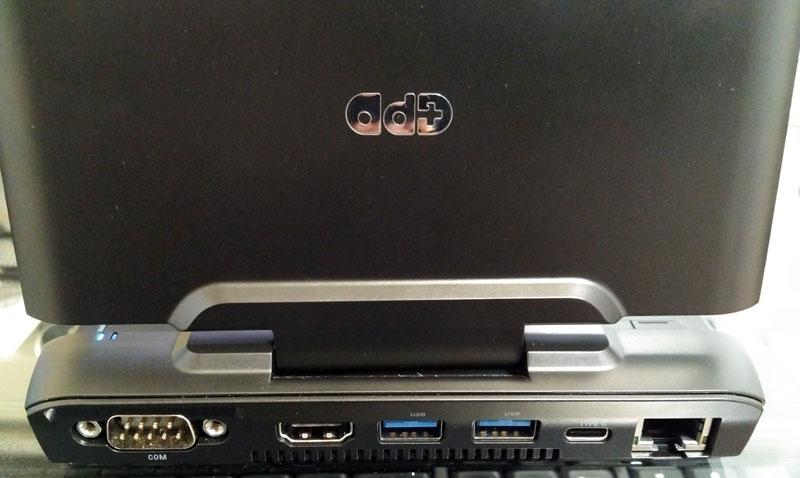
The fan has an actual on-off switch, allowing one to work in quiet when browsing or word processing, employing the relatively noisy cooling system only for high resource tasks. When a maximum temperature is reached, the machine will throttle its CPU to protect itself. Furthermore, the BIOS gives power choices from 4 to 10 watts. Since I don’t game, I choose 6 watts which keeps temperatures cooler and battery life longer. As of yet, there is no over/under clocking in Windows or Linux, but for expert users, there is a scary-mary unlocked BIOS, available by request only, that apparently offers pages of tweaks and enablings and will brick-your-device/void-your-warranty upon one false move. I passed; the wattage control is all I need. Real-life battery time, that inherently subjective dilemma. GPD avers that MicroPC battery life is 6-8 hours and that’s what I get, too. But coming from H/PC, I’m already mingy with battery power. I disable WiFi, fiddle with brightness, root out unneeded services, download rather than stream Netflix. At the end, I would compare the average battery life of the MicroPC to that of a judiciously-used Jornada 720. Backed by 8GB of RAM, the 4-core Intel Celeron N4100 is not the strongest CPU out there, but it boots Windows 10 Pro x64 (the stock OS) quick enough and there is little lag time as applications open. The 128GB M.2 SSD is user replaceable with no size limitation. The SoftwareGPD puts no bloat or sponsorware into its install of Windows 10 Pro, but MS tries its best to make up the difference. Still, everything unwanted can be safely jettisoned. Browsing is peppy - pages load quickly, full-screen YouTube videos play at 1080p. The microphone functions adequately and the internal speakers have volume enough for playback or audio calling.
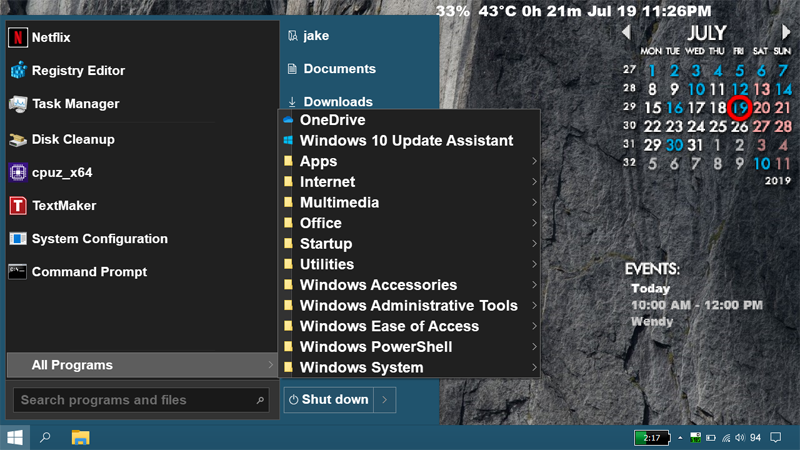
Personally, I find the Modern Apps start menu to be cumbersome on a small screen, so I gladly spent $4.00 USD (£3.31 GBP, €3.80 EUR, ¥597.19 JPY est.) for StartIsBack, a friendlier, CE-like menu. As any CE user knows, more screen real estate is always one’s Mecca. In both Windows 10 Pro and Xubuntu 18.04, there are ways to get the most space without sacrificing visibility.
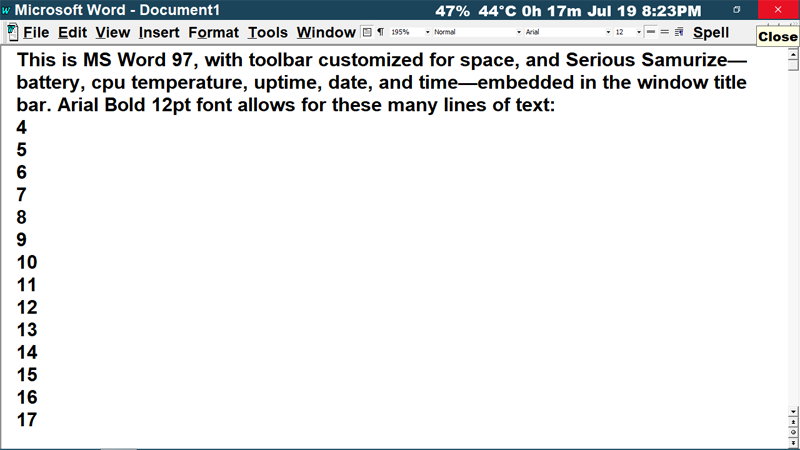
One particular space-saver is the ancient freeware Serious Samurize application that still runs nicely on Windows 10 Home and Pro. Samurize displays machine vitals from time to cpu temperature and the print-out can be placed anywhere. By displaying Samurize’s user-chosen statistics in an empty part of a windows title bar, Windows’ taskbar/systray can be hidden, unneeded, for the vast majority of computing time. For those interested, my script for this particular Serious Samurize layout can be downloaded in the Script Resources attachment at the end of this article. While Serious Samurize will not run in Linux, the xfce4 panel already allows similar statistics and embedding:

The only rub with xfce4’s embedding is that a non-static window title bar will spill its changing name into the panel. A script to prevent this - grepping Chrome’s changes and renaming the page simply “Chrome” with the script killing itself upon program exit - is also found at the end of this article. Obviously, this script can be modified to work with any Linux program whose window titling is not persistent. For example, I also use it for xubuntu’s text editor. Linux installation and subsequent dual booting on the MicroPC is easier than it was a month ago and will continue to be easier in the future. Initial display issues have resulted in official kernel patches. Ubuntu Mate - months behind schedule - has at last an official distro for the MicroPC. For installing other Linux flavors, guides kick up here and there. The best place for Linux help remains discordapp.com in the gpdmicropc_general section. A few words about purchasingI was an Indiegogo backer of the MicroPC and received one of the first machines off the factory line for $314.00 USD (£259.50 GBP, €298.43 EUR, ¥46,879.42 JPY est.), a very fair price for what you get. Even so, GPD is a small company with limited quality control. Couple that with language issues and unhappy customers can be found. If you look closely at the hinge in the first picture, you’ll see that the screen tilts ever so slightly to the right. That’s pretty much how they come and luckily, it’s only cosmetic. But several new users have had to return machines with failed USB ports or uncorrectable hinge problems, and GPD response can be slow, unclear, or both. Kendy (kendyz[AT]gpd.hk) is the fixer and he occasionally posts at reddit in the GPD section. I believe him to be sincerely interested in his customers but keep in mind that English is not his first language. By and large, backers are very content, some even ecstatic with the MicroPC. Now that the machine is available for retail, the price has gone up. As of this writing, LANRUO on Amazon is selling the for $479.00 USD (£395.87 GBP, €455.25 EUR, ¥71,513.51 JPY est.). A hefty increase to be sure, but LANRUO is an excellent seller and Amazon revels in its customer support. Should your MicroPC arrive with defects, you will be tended to, and the cheaper vendors - GearBest, Alibaba, et al - provide imperfect support at best, hence their lower prices and slower shipping. Since the initial run of the MicroPC was only 2000 units (though they are now making more), production may be limited, and in light of this, and GPD’s fledgling status, I would buy only from proven sellers and deal only with them post-sale.
|
| Pros: Almost every port imaginable; sharp screen resolution; backlit keyboard; easy fan control; Linux; one-of-a-kind device Cons: No touchscreen, poorly laid-out fn keys; best of luck to left-handed people; battery life could be better; must jiggle a lot of handles to properly display Windows/Linux; late-night wondering if this is really a handheld | ||||||||||
Further Discussion
Let us know what you thought of this review and the GPD MicroPC Handheld Computer in the Community Forums!

 “What is to be done?”
“What is to be done?”